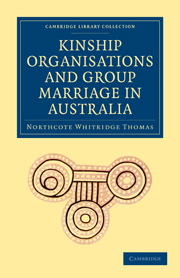Book contents
- Frontmatter
- PREFACE
- Contents
- BIBLIOGRAPHY
- INDEX TO ABBREVIATIONS
- CHAPTER I INTRODUCTORY
- CHAPTER II DESCENT
- CHAPTER III DEFINITIONS AND HISTORY
- CHAPTER IV TABLES OF CLASSES, PHRATRIES, ETC.
- CHAPTER V PHRATRY NAMES
- CHAPTER VI ORIGIN OF PHRATRIES
- CHAPTER VII CLASS NAMES
- CHAPTER VIII THEORIES OF THE ORIGIN OF CLASSES
- CHAPTER IX KINSHIP TERMS
- CHAPTER X TYPES OF SEXUAL UNIONS
- CHAPTER XI GROUP MARRIAGE AND MORGAN'S THEORIES
- CHAPTER XII GROUP MARRIAGE AND THE TERMS OF RELATIONSHIP
- CHAPTER XIII PIRRAURU
- CHAPTER XIV TEMPORARY UNIONS
- APPENDIX: ANOMALOUS MARRIAGES
- INDEX OF PHRATRY, BLOOD, AND CLASS NAMES
- INDEX OF SUBJECTS
- Plate section
CHAPTER III - DEFINITIONS AND HISTORY
Published online by Cambridge University Press: 05 February 2012
- Frontmatter
- PREFACE
- Contents
- BIBLIOGRAPHY
- INDEX TO ABBREVIATIONS
- CHAPTER I INTRODUCTORY
- CHAPTER II DESCENT
- CHAPTER III DEFINITIONS AND HISTORY
- CHAPTER IV TABLES OF CLASSES, PHRATRIES, ETC.
- CHAPTER V PHRATRY NAMES
- CHAPTER VI ORIGIN OF PHRATRIES
- CHAPTER VII CLASS NAMES
- CHAPTER VIII THEORIES OF THE ORIGIN OF CLASSES
- CHAPTER IX KINSHIP TERMS
- CHAPTER X TYPES OF SEXUAL UNIONS
- CHAPTER XI GROUP MARRIAGE AND MORGAN'S THEORIES
- CHAPTER XII GROUP MARRIAGE AND THE TERMS OF RELATIONSHIP
- CHAPTER XIII PIRRAURU
- CHAPTER XIV TEMPORARY UNIONS
- APPENDIX: ANOMALOUS MARRIAGES
- INDEX OF PHRATRY, BLOOD, AND CLASS NAMES
- INDEX OF SUBJECTS
- Plate section
Summary
Before proceeding to deal with the Australian facts it will be well to define the terminology to be employed, and give a brief survey of a typical organisation. Looking at the population from the territorial point of view in the first place, we find aggregates of tribes; these may be termed nations. The component tribes are friendly, one with another; they may and often do hold initiation ceremonies and other ceremonials in common; although the language is usually syntactically the same, and though they contain many words in common, the vocabularies differ to such an extent that members of different tribes are not mutually intelligible. How far the occurrence of identical kinship organisation and nomenclature should be taken as indicating a still larger unity than the nation is a difficult question. Primâ facie the nation is a relatively late phenomenon; but the distribution of the names of kinship organisations, as will be shown later, indicates that communication, if not alliance, existed over a wide area at some periods, which it is difficult to suppose were anything but remote.
The idea of the tribe has already been defined. It is a community which occupies a definite area, recognises its solidarity and possesses a common speech or dialects of the same.
Between the tribe and the family occur various subdivisions, known as sub-tribes, hordes, local groups, etc., but without any very clear definition of their nature.
- Type
- Chapter
- Information
- Kinship Organisations and Group Marriage in Australia , pp. 29 - 40Publisher: Cambridge University PressPrint publication year: 2010First published in: 1906



